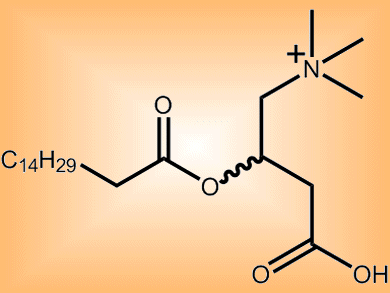Bacteria growing in biofilms are often in metabolic and physiological states that do not respond well to antibiotics, and thus, are major contributors to chronic diseases. For example, Pseudomonas aeruginosa is a prominent cause of chronic infections in people with cystic fibrosis, immunecompromised patients, and burn victims. Biofilm inhibitors have the potential to be used alone or as adjuvants to conventional antibiotic therapies.
Lori Burrows and co-workers, McMaster University, Hamilton, Canada, have screened protein kinase inhibitors for molecules that modulate biofilm development. The screen revealed that the protein kinase C inhibitor, palmitoyl-dl-carnitine (pdlc, pictured), blocks biofilm formation by the pathogen P. aeruginosa. The molecule stimulates motility, blocks quorum sensing and overrides at least two biofilm-stimulatory cues.
This class of compound has potential utility as an antibiotic adjuvant, not only by blocking aminoglycoside-mediated biofilm stimulation but also by preventing bacteria from entering a biofilm state that is tolerant of conventional antimicrobials. Since pdlc blocks biofilm formation by a combination of mechanisms, resistance to its effects is less likely to arise.
- Palmitoyl-dl-Carnitine is a Multitarget Inhibitor of Pseudomonas aeruginosa Biofilm Development
I. B. Wenderska, M. Chong, J. McNulty, G. D. Wright, L. L. Burrows,
ChemBioChem 2011.
DOI: 10.1002/cbic.201100500




